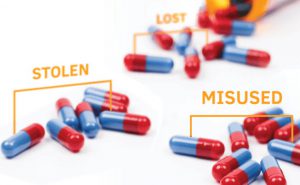 More than 63,600 people died from a drug overdose in 2016, according to the Drug Overdose Deaths in the United States report from the National Center for Health Statistics, part of the U.S. Centers for Disease Control and Prevention (CDC). That equates to a startling 174 lives lost every day to overdose. A majority of these fatalities resulted from opioids, which includes illicit substances such as heroin, fentanyl, and tramadol, as well as prescribed medications, such as oxycodone and hydrocodone.
More than 63,600 people died from a drug overdose in 2016, according to the Drug Overdose Deaths in the United States report from the National Center for Health Statistics, part of the U.S. Centers for Disease Control and Prevention (CDC). That equates to a startling 174 lives lost every day to overdose. A majority of these fatalities resulted from opioids, which includes illicit substances such as heroin, fentanyl, and tramadol, as well as prescribed medications, such as oxycodone and hydrocodone.
Some key findings include:
- Overdose rates were most significant in adults between the ages of 25 and 54
- Drug overdose rates were significantly higher for males than females
- West Virginia, Ohio, and New Hampshire ranked the highest in overdose death rates
- Iowa, North Dakota, and Texas ranked the lowest in overdose death rates
Authors of the report studied data from 1999 to 2016 and said, “The pattern of drugs involved in drug overdose deaths has changed in recent years. The rate of drug overdose deaths involving synthetic opioids other than methadone (drugs such as fentanyl, fentanyl analogs, and tramadol) doubled in a single year from 3.1 per 100,000 in 2015 to 6.2 in 2016. Additionally, it’s important to note that many drug overdose deaths may involve multiple drugs.
The National Governors Association released a list of recommendations on January 18, 2018, which was the “first coordinated, bipartisan response” since President Trump declared the opioid crisis a public health emergency in October 2017, according to TIME. Government leaders, policymakers, physicians, and scientists continue to seek strategies that help prevent misuse and addiction, reduce harmful consequences and fatalities from drug overdoses, and to provide substance abuse treatment and support.
To learn more about drug testing, visit our website.
 Your Privacy Choices
|
Privacy Notices
|
Terms
|
Language Assistance / Non-Discrimination Notice | Asistencia de Idiomas / Aviso de no Discriminación | 語言協助 / 不䈚視通知
Your Privacy Choices
|
Privacy Notices
|
Terms
|
Language Assistance / Non-Discrimination Notice | Asistencia de Idiomas / Aviso de no Discriminación | 語言協助 / 不䈚視通知



















Some key findings include:
Authors of the report studied data from 1999 to 2016 and said, “The pattern of drugs involved in drug overdose deaths has changed in recent years. The rate of drug overdose deaths involving synthetic opioids other than methadone (drugs such as fentanyl, fentanyl analogs, and tramadol) doubled in a single year from 3.1 per 100,000 in 2015 to 6.2 in 2016. Additionally, it’s important to note that many drug overdose deaths may involve multiple drugs.
The National Governors Association released a list of recommendations on January 18, 2018, which was the “first coordinated, bipartisan response” since President Trump declared the opioid crisis a public health emergency in October 2017, according to TIME. Government leaders, policymakers, physicians, and scientists continue to seek strategies that help prevent misuse and addiction, reduce harmful consequences and fatalities from drug overdoses, and to provide substance abuse treatment and support.
To learn more about drug testing, visit our website.